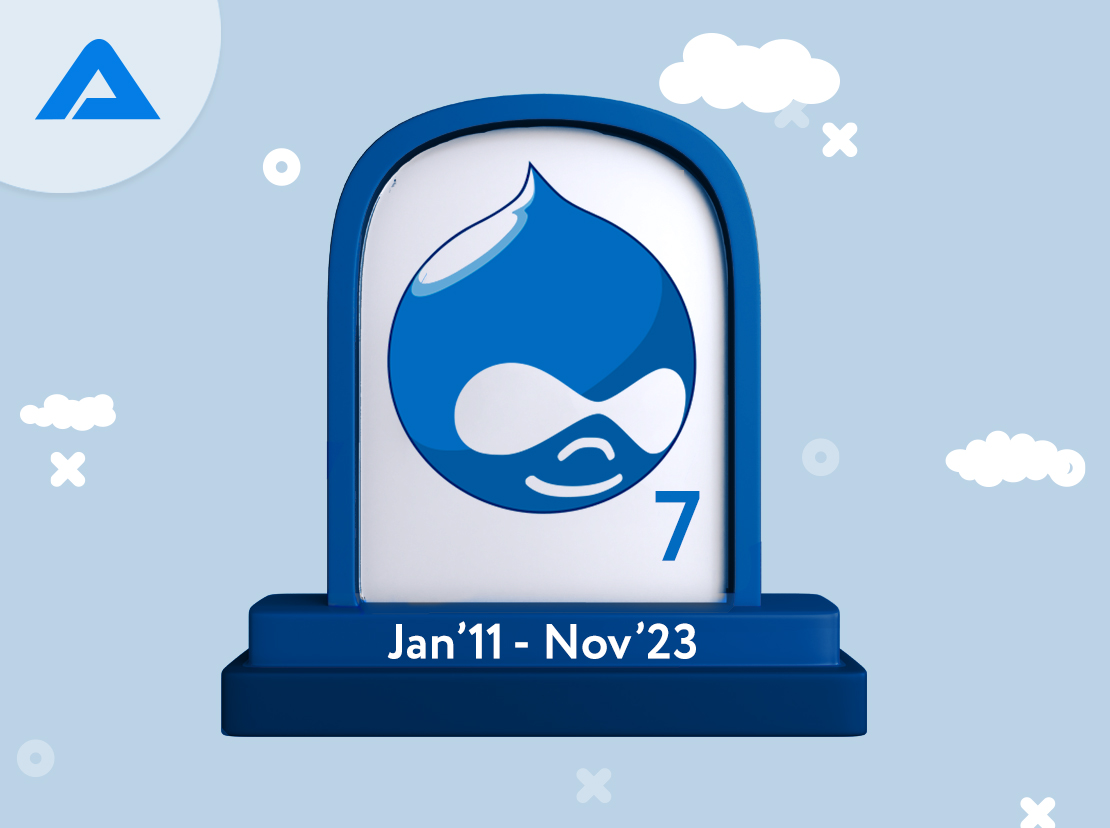Drupal 7 is going to end its run on 1 November 2023. Since its release in January 2011, Drupal 7 has consistently served businesses and website developers for over a decade.
More than half of the Drupal users still use Drupal 7 despite the release of newer versions like Drupal 8, 9, and recently 10, thanks to its impressive features and performance.
As the version reaches its End Of Life (EOL), you must know how to upgrade Drupal 7 to the latest version, 10.
This blog discusses everything you need to know about Drupal migration.
What can you do at the end of Drupal 7?
There are three options that you can consider when it comes to Drupal migration:
- Use a long-term support provider and stay with Drupal 7.
- Carry out Drupal 7 to 10 migration.
- Switch to a whole new CMS like WordPress.
Each of these options requires a unique approach and course of action. We explore each option below to understand which suits your business perfectly.
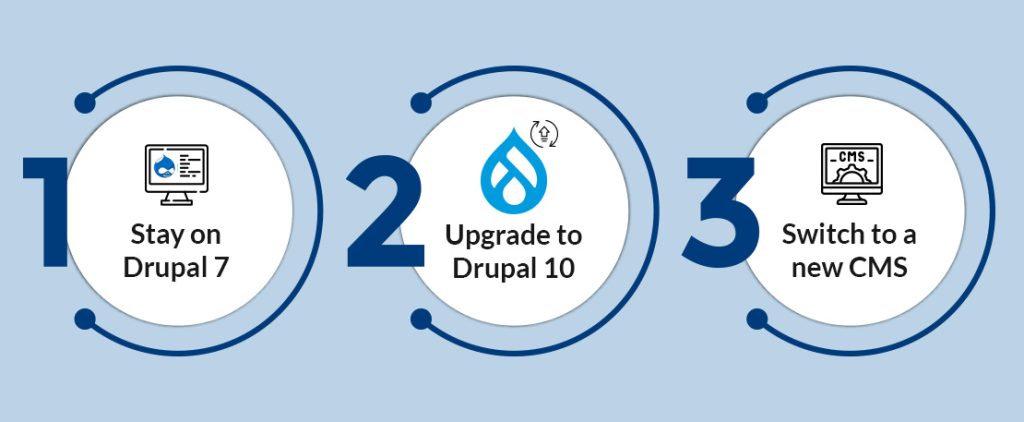
Stay on Drupal 7
If Drupal 7 is nearing its EOL, why would anyone want to stick with it? That’s a genuine concern since the Drupal community will stop providing security updates and bug fixes.
Even after 1 November 2023, Drupal 7 will continue to exist. Instead of the community, a few selected and approved vendors will provide security updates to Drupal 7. The Drupal 7 Vendor Extended Support will also provide a few modules from which users can benefit.
This option is preferred by organizations that need more time and resources to execute Drupal migration 7 to 10 migration. However, one thing such organizations need to keep in mind is that this is a temporary solution.
Sooner, the integrations and modules will stop functioning as intended. Missing new features, security updates, and other core updates is another challenge for a website using Drupal 7 even after its EOL.
Drupal 7 to 10 migration
This is the best option if you are now using Drupal 7, and it will allow you to enjoy new features and functionalities on your upgraded website. The migration will guarantee a better performance that your audience would love.
Some of the top advantages of migrating to Drupal 10 from Drupal 7 are:
Improved site and data security
At the end of Drupal 7, you will stop receiving security updates and bug fixes for the version. This will leave your site vulnerable to attacks and hacking. Upgrading to Drupal 8, 9, or 10 will help you keep getting these updates and bug fixes.
Better user experience
With each new version, Drupal has been improving its user experience to a great extent. Hence, when you migrate to Drupal 8,9 or 10, this will reflect on your website.
Superior site performance
Every new iteration of Drupal comes loaded with new technologies and performance tweaks. This ensures that your site is not only easy to use for its visitors but also easy to manage for admins like you.
Better UX on mobile devices
With mobile internet growing like nothing else, how your site renders on mobile devices and performs on hand-held devices is also crucial to your business. When you upgrade Drupal 7 to its later versions, you deliver an impressive user experience that everyone will love.

Looking to hire a Dedicated Development team for your project?

Pooja Upadhyay
Director Of People Operations & Client Relations
Migrating to other CMS platforms
This is another choice when considering leaving Drupal 7 behind. This would allow your website to have a new look and feel. However, one must be very careful when migrating from Drupal 7 to another CMS platform.
The entire process may cost you time and be very expensive if not done correctly. Hence, if you are considering migrating to another CMS from Drupal, you must work with a Drupal agency to ensure everything goes well.
You have three options when looking to migrate to another platform. They are as given below:
Drupal to WordPress Migration
If you are thinking of changing how your site is used, migrating your site from Drupal 7 to WordPress could be an excellent choice. The migration can be beneficial if you want easy-to-manage CMS and e-commerce capabilities than just a content management platform.
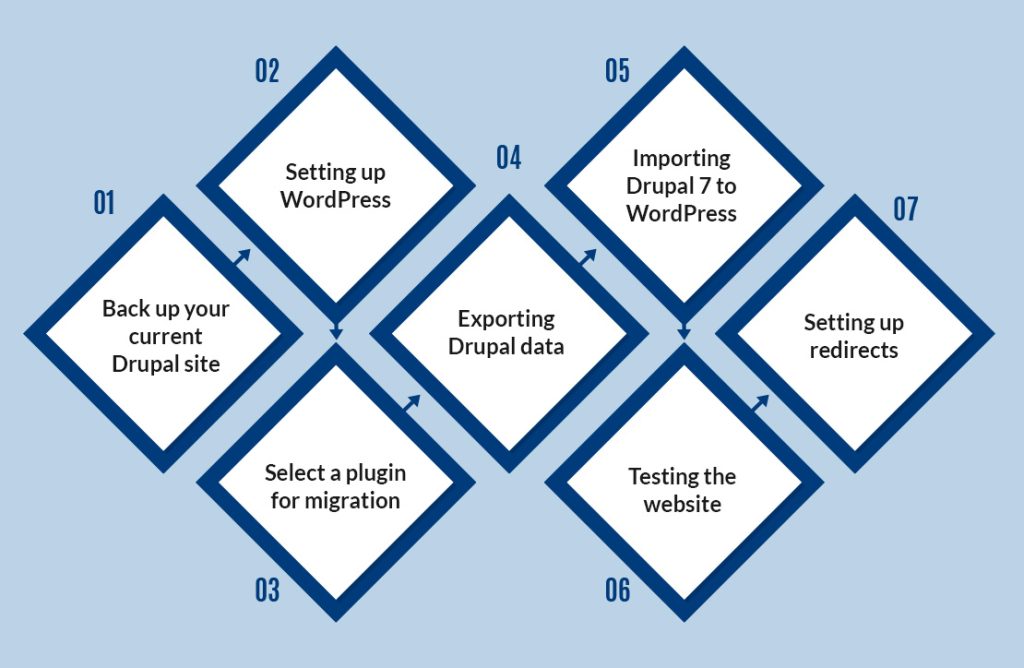
However, be informed that this is a rather complex process. It takes time, the right expertise, and tools to get the desired results.
The following are the steps to migrate from Drupal 7 to WordPress:
Step 1: back up your current Drupal site
Before making any changes, it is a good habit to back up your Drupal website. You must back up the files and the database to be on the safer side. If you wish to roll back to Drupal, the backup would greatly help.
Further, the backup will be a baseline when you start the content migration process.
Step 2: Setting up WordPress
In this step, you must install the WordPress platform on a hosting account of your choice. You can install it manually or use Softaculous, a one-click installer solution.
If your website is complex and large, we advise creating the site in a local development center for trouble-free hosting.
Step 3: Select a plugin for migration
Any migration plugin can transfer content from Drupal 7 to WordPress. Some popular and reliable plugins are CMS2CMS and FG Drupal to WordPress plugins.
The ideal way to migrate is to develop a map for the transfer. This must connect the source with the destination–Drupal and WordPress.
If you find migration challenging, seek the help of a company offering Drupal development services.
Step 4: Exporting Drupal data
This is where you export Drupal data into a format that is easy to migrate to WordPress. The data includes pages, media, posts, etc. The chosen migration tool will guide you if you don’t know how to do it.
Step 5: Importing Drupal 7 to WordPress
Here, you import the Drupal 7 data into WordPress. The plugin will do the job, bringing respective data into appropriate fields in WordPress and creating posts and pages.
Step 6: Testing the website
After migrating Drupal 7 to WordPress, the final step is to test the site. Have a Drupal migration checklist handy to ensure the migration is as intended.
Testing the site will guarantee that the site performs as you want.
Step 7: Setting up redirects
After migration, the last step is setting up URL redirects to ensure that your old URLs point to the correct URL in the new WordPress platform.

Choose Headless with Drupal
When going the headless route with Drupal, there are two different elements you need to take care of.
- Drupal is the backend CMS to store and manage your site’s content.
- A separate front-end framework like React or Angular to build the site’s front end.
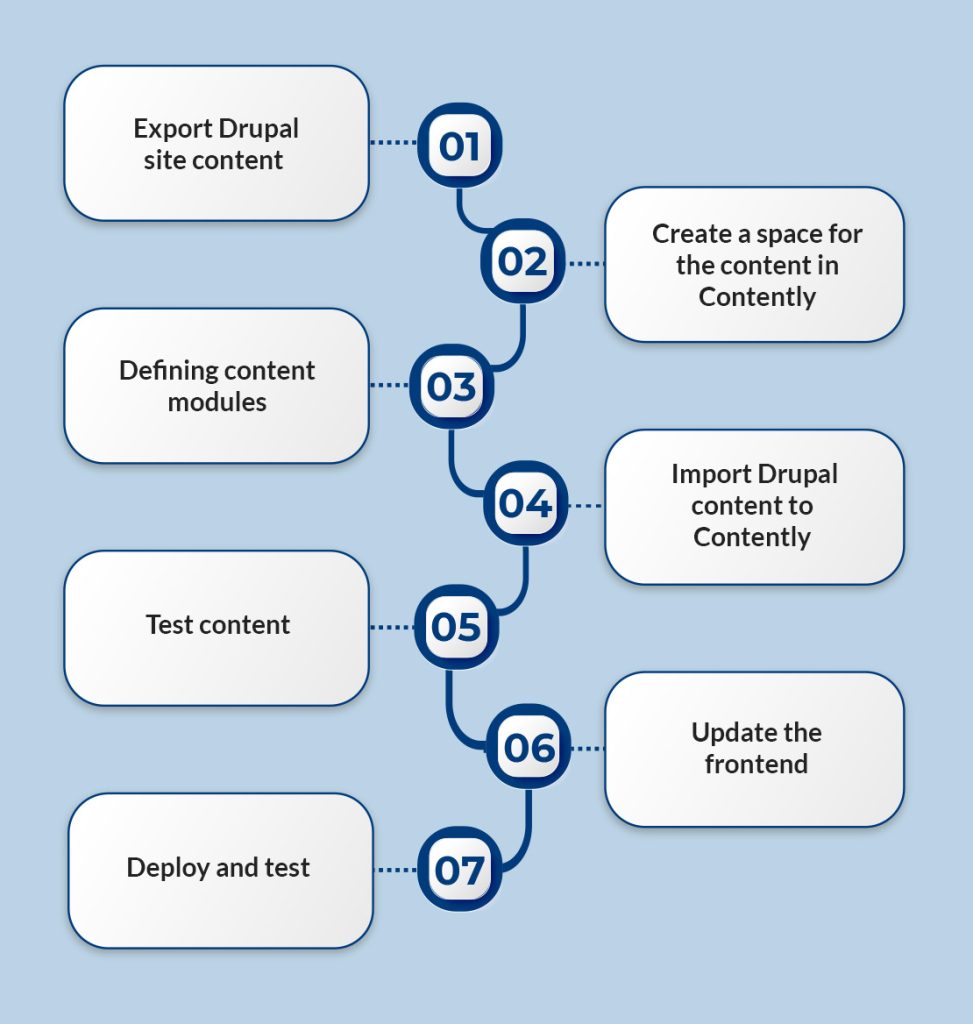
Going headless from your existing Drupal 7 will give your users a new experience. Improved performance is another advantage of choosing to go with the headless option.
There are six steps in setting up a headless application on Drupal for your website. These steps are given below:
Step 1: Setting up a Drupal instance
The first step of creating a headless app for your site is to make the backend CMS. You will store and manage the content on the website using this CMS. This can be quickly done with the help of a personal server or an authorized Drupal hosting agency.
Step 2: Defining content fields and types
In this step, you must define the content types and fields to store data from your existing site and the new content you create going forward.
Step 3: Create and manage your content
After setting up the content type and fields, you can create and manage content from Drupal.
Step 4: Develop the frontend
This is where you build the front end of the headless app. You may seek the help of a React or Angular expert like AddWeb Solution to do it for you.
Once the development is done, the front end will send API requests to the Drupal CMS to collect and render user data.
Step 4: Deploy the headless app and test
Like any other website or app, this must also be tested for performance and user experience. If you find any glitches or lapses in performance, contact any Drupal agency to sort the issues out.
Migrating to Contently
When migrating to Contently CMS from Drupal, you need to migrate your website content to the Contently CMS. You need to do this very carefully and strategically.
The best way to complete the process without losing data or functionalities is to plan the migration process from the start.
After planning the same, you can follow the steps given below:
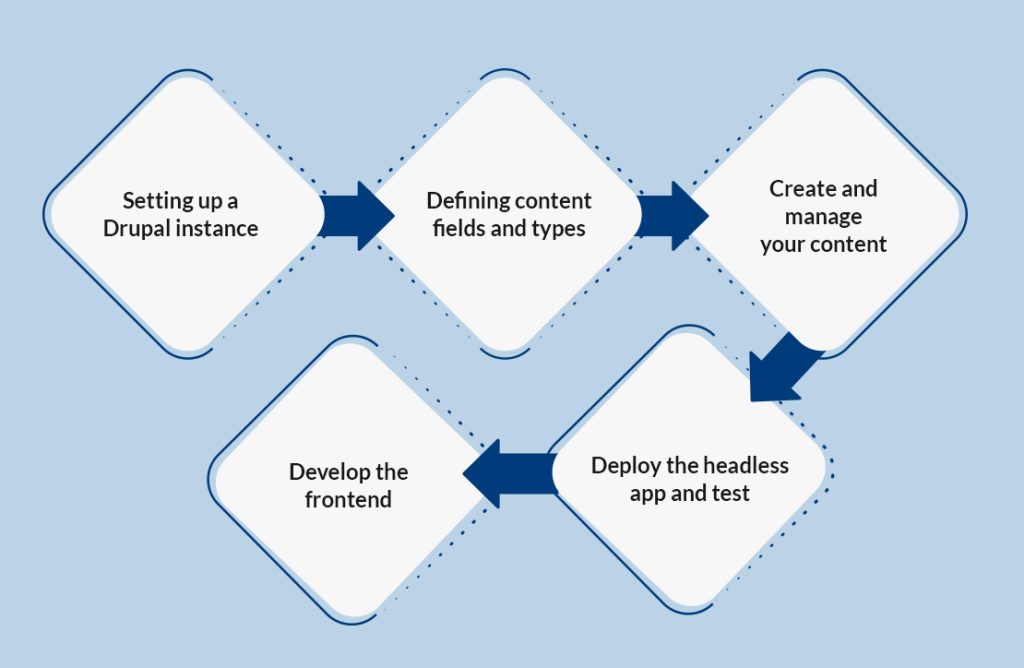
Step 1: Export Drupal site content
First, you must export your site content into a format that can be brought to Contently. You can use a Drupal module like the Views Data Export module.
Step 2: Create a space for the content in Contently
In this step, you must create a space to export the content from Drupal.
Step 3: Defining content modules
You must now define the content modules in Contently to match the content types in Drupal 7. This helps define the content modules, such as images, text, etc.
Step 4: Import Drupal content to Contently
This is where the accrual migration process takes place. You can use the Contently API or Contently CLI to import content.
Step 5: Test content
This is a step that most businesses take when migrating content from Drupal to Contently. However, this is a crucial step, and you must test the content to see if it is performing as intended.
Step 6: Update the frontend
Suppose you are using a frontend framework, such as Angular or React, to display the content of your website. In that case, you must update it to retrieve the content from the newly migrated Contently platform rather than Drupal.
Step 7: Deploy and test
This is the last step of your Contently migration from Drupal 7. You must test the website to ensure it performs as expected and has no glitches. If there is any, you need to find out what causes the issue and address it with the help of a Contently expert.
Conclusion
It is challenging for businesses to carry out Drupal migration from 8 to 9 or 7 to any higher version. If you look at Drupal migration when Drupal 7 reaches its EOL, you are better off doing it with a reliable agency offering Drupal development services. Being a proud member of the Drupal community, AddWeb Solution can help you with everything you need for Drupal 7 to 10 migration.
AddWeb Solution is one of India’s most respected Drupal development agencies, offering its clients professional, advanced, and top-notch services for years. We have highly experienced Drupal developers and experts who can face any challenge regarding Drupal migration.
You may check our portfolio section to understand how we have served our clients and what makes us one of the most reliable names in Drupal development.
So, what are you waiting for? Contact our client support team to create a strategy for smooth and seamless Drupal migration.
Frequently Asked Questions
It’s like marking a calendar event. The official end of life for Drupal 7 was November 28, 2022. After this date, Drupal 7 will no longer receive community support and security updates.
Absolutely! It’s like deciding to upgrade your operating system. While you can continue using Drupal 7, it’s strongly recommended to migrate to Drupal 8 or 9 for ongoing support and security updates.
It’s like planning a road trip. While direct migration from Drupal 7 to Drupal 9 is possible, you may need to review and update contributed modules and themes for compatibility.
It’s like having a safety net. Thoroughly plan your migration, back up your data, and perform testing to identify and address any issues before completing the migration.
Yes! It’s like updating your wardrobe for a new season. Update your custom code and configurations to align with Drupal 9 coding standards and best practices for a seamless transition.
Absolutely! It’s like having a team of experts. The Drupal community, documentation, and forums provide valuable resources. You can also seek professional assistance from Drupal developers or agencies for a smooth migration.

Looking for Drupal Migration Expert?

Pooja Upadhyay
Director Of People Operations & Client Relations

